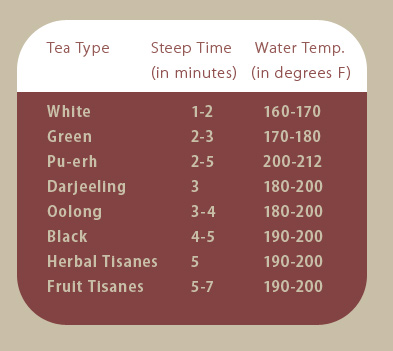












Throughout history, cultures around the world have been making tea from the Camellia Sinensis plant (also known as the Tea Plant). By first harvesting the buds and leaves and then oxidizing them in different ways, white, green, pu-erh, oolong and black tea can be yielded. Methods vary widely; in turn, each tea type branches into its own broad spectrum of tea variants. Herbal teas produced without the Camellia Sinensis plant are called tisanes and are technically not classified as Tea; however, they can be just as enjoyable. Examples of popular tisanes would be: chamomile, rooibos, or hibiscus. [1]

Oxidation occurs when enzymes stored in the veins of the buds and leaves react to oxygen in the air. Increased exposure correlates to less antioxidants in the tea and can be attained by pressing, rolling, bruising or tearing the leaves. During the tea making process, black teas require the most oxidation, but some antioxidants still remain. White and green teas require little to no oxidation; in order to neutralize the plant’s enzymes and skip any oxidation, leaves and/or buds are steamed and then dried. [2]
The term fermentation in the tea making industry actually has nothing to do with alcohol. Many use the words oxidation and fermentation interchangeably, making the separation fuzzy. Fermentation, like oxidation, begins after cell rupture; polyphenol and other enzymes are exposed to air and create colored compounds such as theoflavins and melanins (the same chemical that causes a partially eaten apple to turn brown). The conditions during the fermenting process have a strong impact on the color, flavor, and strength of tea. For example, the thickness of spread, room temperature and humidity all factor in. When the producer decides to halt the oxidation or fermentation process, the leaves are dried. The total moisture in the buds and/or leaves are reduced to about 3% and the enzymatic activity stops. [3]
Most people know in order to make tea, leaves need to be steeped in hot water for a
brief period of time. But, not all know how to achieve the perfect cup of tea. Different types of tea require various steep times and water temperatures, follow the chart below as a guide.
Remember that this is a general guide and tea types can vary widely. Check with your tea producer to find the most accurate brewing instructions.
Fill a kettle with freshly drawn cold water. We recommend using filtered water because the quality of your water will directly affect the taste of your tea. Many towns have water that has too much chlorine and other minerals. When the water is near the boiling point, pour a little into the teapot, swirl around, and pour out. This leaves a hot, clean teapot.
Measure the tea carefully into your teapot, allowing one rounded teaspoon or one tea bag for each cup required. Many people prefer to use a tea ball or filter to keep the leaves from spreading throughout the teapot. Bring the water to a rolling boil. Do not allow it to boil too long, as it will boil away some of the flavor-releasing oxygen and result in a flat cup of tea. Please note that green and white tea should be made with water that has boiled and allowed to cool for just under a minute.
Pour the water onto the leaves or tea bags. This saturates the tea allowing the flavor to release naturally. Do not pour the water and then add the tea, this will only result in a poor cup of tea.
If you prefer your tea stronger or weaker, never vary the brewing time; simply increase or decrease the amount of tea. If allowed to sit in the teapot, the tea can over-brew and turn bitter. Some green, oolong and white teas are good for multiple infusions, just add new hot water to the pot and increase the steeping time slightly. Repeat until the flavor starts to fade. Learn other ways to achieve a perfect cop of tea!
The healthy effects of tea have been studied ever since its invention by Shen Nung. The Chinese Emperor believed the drink could cure tumors, abscesses, bladder ailments, and lethargy. Treating lethargy with tea can get slightly dangerous; some people who feel exhausted could actually have an iron deficiency and the tannins in tea hinder the body’s absorption to iron (along with calcium and protein). The overall lesson here is not to trash tea, but rather to further examine the chemical components of tea and how they effect the body’s health. Remember also that scientific results from research can be used as a good guide, but research does differ and change over time.
Green Tea May Help Fight Glaucoma and Other Eye Diseases
• Scientists have confirmed that the healthful substances found in green tea (the powerful antioxidant and disease-fighting properties) also penetrate into tissues of the eye. Their new report, documenting how the lens, retina, and other eye tissues absorb these substances, raises the possibility that green tea may protect against glaucoma and other eye diseases. Read the article online
An Overview or Research on the Potential Health Benefits of Tea
• Numerous studies have been published demonstrating the positive impact tea has on health. The following link summarizes key findings from multiple studies, including positive impacts on Coronary Heart Disease, Cancer, Kidney Stones, and Osteoporosis. Read the article online
Green Tea May Slow Prostate Cancer Progression
• Certain compounds in green tea were found to have an influence on the progression of prostate cancer. The studied substance,
polyphenol, was found to significantly reduce the serum markers predictive of prostate cancer progression. In collaboration with Columbia University in New York City, the researchers are currently conducting a comparable trial among patients with breast cancer. Read the article online
Black Tea May Fight Diabetes
• According to a study published in Journal of Food Science, black tea has the potential of managing the development of diabetes. Chinese scientists, examining the polysaccharide levels of different tea varieties, found that polysaccharides in black tea had the most glucose-inhibiting properties. Polysaccharides are a type of carbohydrate that may benefit people with diabetes because they help retard absorption of glucose. Black tea polysaccharides are also shown to have the highest scavenging effect on free radicals, which are involved in the onset of diseases such as cancer and rheumatoid arthritis. Read the article online
Works Cited
[1] • K. K. Agarwal, Assignment of Food Beverages
[2] • Robert J. Heiss, Oxidation and Fermentation in Tea Manufacture
[3] • Fermentation